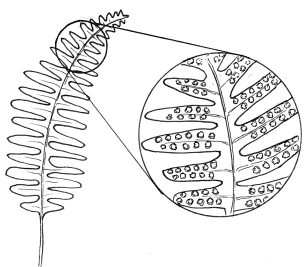FernsFerns possess large, intricate leaves (fronds), vascular tissues,
and well-formed root systems. They provide us with a good example of the evolutionary
progression to the dominance of the sporophyte, or spore-producing, generation.
Most gardeners have observed the neat rows of dots on the
undersides of fern fronds. These are spore capsules; when they dry and break open, huge
numbers of tiny, dust-like spores are released. If a spore lands in a suitable spot and
germinates, it will grow into a small, heart-shaped plant just � inch across. These tiny
plants (which generally remain unnoticed) represent the gametophyte generation,
responsible for producing both male and female gametes—the sperm and eggs. Once
united, these gametes form the zygote and eventually the familiar fern. The life cycle is
complete when the mature fern produces spores. Unlike mosses, for which the gametophyte is
the conspicuous phase, the dominant phase for ferns is the sporophyte generation.
Ferns are classified as seedless vascular plants. They
contain vascular tissues (xylem and phloem) which distinguishes them from the mosses.
However, like mosses, their developing embryos are not enclosed in seeds.

